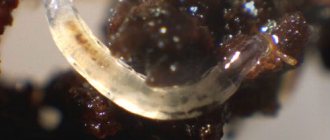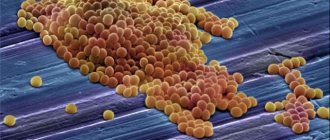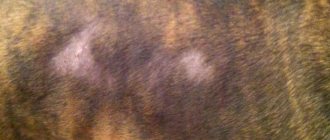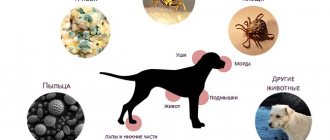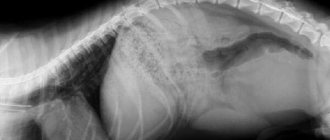Canine chlamydia is a common, very dangerous zooanthroponotic infectious disease. The disease of our four-legged friends is caused by microorganisms of the species Chlamydophila psittaci and Chlamydophila abortus, which, parasitizing in the body of animals, cause a wide range of clinical manifestations. Chlamydia in dogs is accompanied by keratoconjunctivitis, blepharitis, abortion, the birth of non-viable offspring, damage to the digestive tract (enteritis), disruption of the functioning of the respiratory system, urethritis, arthritis, encephalitis, orchitis. Most often, chlamydia affects the genitourinary system in dogs and other animals.
Chlamydial infections, which are widespread, affect dogs regardless of age and breed. The infectious disease poses a serious threat to the lives of animals, especially for small puppies with a fragile immune system, weakened, emaciated dogs, and dogs of older age groups.
Description of the disease
Chlamydia is an infectious disease. It is caused in dogs by intracellular parasites of the chlamydia genus. There are many known species, but Chlamydophila psittaci, Chlamydophila felis and Chlamydophila pneumonia are potential dangers for dogs.
Chlamydia, if we take the disease into account, is not common among dogs and is extremely rare. But some dogs can be carriers - when tested, they will be positive for chlamydia, but most often there are no clinical symptoms.
This is due to the variety of types of chlamydia. Diagnostic tests make it possible to determine the presence of chlamydia in a dog’s body in principle, and not their specific type.
Only three types of chlamydia cause clinical symptoms in dogs. Most often it is Chlamydophila psittaci (psittaci).
The clinical manifestation of the disease depends on the localization of this intracellular parasite in the body and on the specific type of pathogen.
The most common forms of manifestation are:
- conjunctivitis;
- damage to the respiratory system;
- reproductive pathologies.
What is chlamydia
Chlamydia is an intracellular gram-negative bacteria. In their desire to “get” inside the host cells, they are similar to viruses, which are also intracellular parasites. This is precisely the main danger of chlamydial infection - any organ, any tissue of the dog’s body can be affected.
In the recent past, a taxonomy with two genera was used in veterinary medicine and medicine, but scientists have long proven the “underestimation” of this group of microorganisms. It turned out that there are much more of them, and therefore their systematization is much more difficult. It is now believed that there is only one species and nine strains (abortus, caviae, felis, muridarum, pecorum, pneumoniae, psittaci, suis and trachomatis). A comparison of the genome showed that the difference between many subtypes is extremely insignificant, which suggests great variability and the possibility of the existence of “transitional” varieties in nature. This assumption is partly confirmed by the fact that relatively recently researchers discovered two new strains - C. avium and C. gallinacea.
Causes and symptoms
Chlamydophila felis is chlamydia, found mainly in cats, but also found in dogs. It can cause eye damage - conjunctivitis, and damage to the respiratory system - rhinitis, etc.
Despite the fact that this type of chlamydia causes clinical symptoms, the disease is not severe, is treatable and does not threaten the pet’s life.
Chlamydophila pneumonia is a zooanthroponosis, in other words, a disease common to humans and animals, that is, a person can become infected from his pet. But more often the situation is the opposite.
In dogs, this parasite causes pneumonia, but the course is not typical and is complicated by atherosclerosis.
Chlamydophila psittaci. It is this parasite that causes a vivid clinical picture and complications that are very dangerous for the dog’s life.
Symptoms may vary depending on the location of the parasite and the animal’s immunity:
- increased body temperature;
- loss of appetite;
- inflammation of the conjunctiva;
- discharge from the eyes;
- nasal discharge;
- difficulty breathing;
- copious discharge from the genitals;
- the birth of non-viable offspring.
- abortions (if it comes to this, often mother and fetus die at the same time).
The cause of death with this type of chlamydia is often effusion into the chest cavity.
How does infection occur?
How a dog can be infected with chlamydia is also a controversial issue.
The widespread belief that the disease is transmitted sexually is supported by only a few studies.
Infection with Chlamydia psittacy occurs mainly from birds:
- when eating poultry meat;
- in contact with birds and their secretions.
Chlamydia is transmitted from other animals:
- by contact;
- airborne (by sniffing, licking);
- intrauterine - in pregnant females from mother to fetus;
- sexually.
Chlamydia is not a bacteria or a virus; it is an intracellular parasite. They enter the environment with feces, various secretions, and aborted fetuses.
In the external environment they are quite resistant (even to some disinfectants). Once in a living cell, they quickly “settle” in it, feeding and reproducing.
All dogs can become infected, regardless of breed or age.
Even place of residence does not matter much. Both city and village dogs are equally likely to get sick.
Diagnosis and treatment
Diagnostics is the most ambiguous thing in this matter.
The fact is that conventional diagnostic methods - serological reactions - make it possible to detect the presence of parasites of the genus chlamydia in the body.
But not all species pose a health risk to dogs. Chlamydia, which is safe for it, could have entered the animal’s body, which does not cause any damage in the body and no clinical symptoms, but the diagnostic test will be positive.
According to the analysis, there is no need to treat, otherwise you can harm your pet.
Only methods that allow you to determine the type of chlamydia have real diagnostic value. Such tests include, for example, detailed PCR.
If your dog is suspected of having chlamydia:
- must be based on the clinical signs of the disease;
- then, consider and rule out differential diagnoses;
- Afterwards, conduct laboratory tests that will allow you to determine the specific type of pathogen.
Accurate testing of a dog for chlamydia
To identify the disease at an early stage, it is necessary to conduct a diagnosis. This is the veterinarian's job. The following methods are used for verification:
- External examination of the animal.
- Questioning the dog owner about the dog's behavior over the past few days.
- Collection of biological materials, laboratory analysis.
The veterinarian must take a smear from conjunctivitis, from the genitals, and draw blood.
Research helps identify the disease. The next step is choosing the right antibiotic. It is important to establish a level of drug concentration that will destroy harmful bacteria in the animal’s body.
Treatment
If a dog is confirmed to have chlamydia, and the identified parasite is Chlamydophila psittaci, then treatment must be taken very seriously, since this disease threatens the pet’s life.
In this case, complex treatment is prescribed, aimed at destroying the causative agent of the disease, restoring the animal’s immunity and symptomatic therapy.
The treatment complex lasts a long time, so even when your pet gets better, the course of medications must be completed.
If the identified parasite is Chlamydophila felis, then the dog’s life is not in danger.
Treatment is definitely necessary and a veterinarian should prescribe treatment specifically for your case.
The most unpleasant thing is when a dog is diagnosed with Chlamydophila pneumonia.
This species can also be dangerous for people.
You cannot cure your dog of this on your own and there is no way you can help it at home. The best option would be to entrust the treatment of your pet to a veterinarian. And you yourself should go to the hospital and check your health.
General clinical picture of the disease
Experts note the existence of two main forms of chlamydia.
The first is Latent. It usually affects animals with a strong immune system. There may be no obvious external signs. Especially at the initial stage of the disease. But the animal is already a carrier of a dangerous virus. Activation of the disease is facilitated by inadequate care, poor living conditions for the animal, unbalanced nutrition, lack of discipline, and lack of control on the part of the owner.
If the disease progresses and actively develops in the body affected by the virus, then externally in the dog it can manifest itself through various diseases, such as rhinitis, arthritis, purulent conjunctivitis.
Prevention
It is not possible to completely protect a dog from this parasite, as it is found everywhere.
Especially Chlamydophila felis (feline chlamydia), since it is very common among cats (about 40% of cats can get sick), and therefore can be transmitted to dogs.
Chlamydophila psittaci is carried mainly by birds; in urban environments it can be pigeons; there is almost nowhere to hide from them.
Well, we must not forget about the sexual transmission of chlamydia, although it is not as common as contact and airborne droplets.
For prevention, we follow the following rules:
- When walking, carefully monitor your pet. Keep him away from stray cats.
- Make sure that the dog does not rush at the birds, and do not even allow him to sniff any carrion.
- If your dog has breeding value, carefully select a mate for it to be sure of the health of both dogs. But remember that the usual tests taken before mating do not provide reliable information. If the reaction to chlamydia is positive, do not rush until you find out the type of chlamydia. Most species do not bother our four-legged friends.
- Eliminate self-walking.
- The pet's immunity should always be strong; this requires high-quality feeding, caring for the animal and the availability of the necessary vaccinations and treatments against external and internal parasites.
Preventive methods
To prevent the disease you should:
- Regular examination of pets.
- Full examination before mating.
- Annual vaccination.
The ChlamyKon vaccine is used to protect against chlamydia . But great responsibility for the health of pets lies with the owner, since the animal itself is helpless in the face of any disease. Unprofessional approach - self-medication can not only worsen the development of chlamydia, but also give the parasites endurance. After this, the animal can become a permanent owner and carrier of the infection.
The danger of spreading the infection can only be avoided by preventing it with preventive actions and by seeking help from specialized veterinary clinics at the first slightest sign of any ailment in the dog.
Briefly about the main thing
- Canine chlamydia is an infectious pathology caused by intracellular parasites of the genus Chlamydophila.
- Only some types of chlamydia pose the greatest danger to the health of dogs, but such pathologies are rare. More often you can find a dog infected with feline chlamydia; it does not threaten the pet’s life, but it causes problems with the eyes and respiratory system, which often manifests itself as conjunctivitis and rhinitis.
- If the dog is infected with a highly pathogenic type of parasite, then the symptoms can be very dangerous: discharge from the eyes and nose, discharge from the genitals, and infertility is possible in the future. In pregnant females, the disease manifests itself as severe abortions. If no measures are taken, death is possible.
- Infection occurs mainly through contact and airborne droplets; sexual transmission is possible. Carriers are cats, birds, other dogs, and rodents. Even humans can carry Chlamydophila pneumonia.
- Diagnosis is a complex issue. The only reliable method is serological tests that allow you to determine the type of chlamydia. Other methods that determine the presence in a dog’s body of antibodies in general to the genus Chlamydophila have no diagnostic meaning.
- To prevent this nuisance, strengthen your pet’s immunity and closely monitor it during walks.
Have we answered your question fully enough? If not, post your question in the comments below and our veterinarian will answer it.
Did you like the article? Share it with your friends on social media. networks. This will help them get useful information and support our project.
